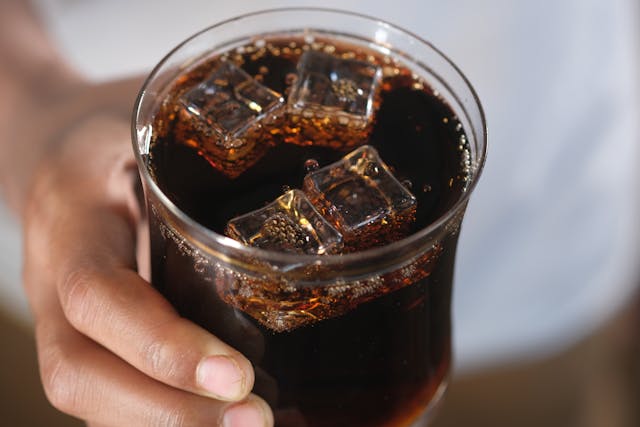
Why does ice float? Ice floats because it is less dense than liquid water. Ice is one of the very few liquids that expand when they are frozen. The majority of materials contract.
Ice floats on water because of its density. A less dense material will always float on a more dense material. The density of ice is 0.9 g/cm3, and the density of water is 1.0 g/cm3. This is because there are two forces acting on an object when it is in a liquid or a gas. The first force is gravity pulling the object down towards the ground. The second force is from the molecules in the liquid pushing the object upwards. The force pushing upwards is called the buoyant force. When you put something in water, it will move water out of its way, or displace it. The amount of water that was displaced has a weight. The upward buoyant force is equal to the weight of the displaced water. If you displace 10 kg of water and the object you place in the water only weighs 5 kg, it will float. If you displace 10 kg of water and the object you put in the water weighs 20 kg, it will sink. Boats float because of this. If you dropped a chunk of steel in a lake, it would obviously sink because the chunk of steel is far denser than the water in the lake. Water is 1 g/cm3, and steel is 7.85 g/cm3. However, if you flatten out the steel into a boat shape with enough space for air, the overall density of the boat drops to lower than that of water, and the boat floats. The water that the boat displaces because of its size weighs far more than the weight of the boat itself. Ice is the same. The interesting question here is not why ice floats. Something less dense will always float in something more dense. The interesting question is why water expands and forms less dense ice when it freezes.
Ice is the solid form of water. It is a solid that is less dense than its liquid form. In almost every case, the solid form of a liquid is denser than the liquid form. Water is not the only material that exhibits this property, but there are not many. Some others are germanium, silicon, and gallium. The majority of solids are denser than their liquid forms because the molecules in solids pack together very tightly. The liquid form comes about when you heat the solid form and apply energy to it. The energy makes the molecules move more and they take up more room. When they are a liquid, they spread out and the same number of molecules takes up more volume. An object’s density is decided by how much mass it has in a certain volume. When the solid becomes a liquid, it spreads out, and the same mass needs more volume. So, if you take the same volume of the solid and the liquid, the solid would be denser. This doesn’t happen with water.
What is it about water that gives it this property? It comes down to the way the molecules in water join together when it is a solid. In most solids, the molecules join together in a shape called a crystal lattice. The molecules arrange themselves symmetrically and very close together. They become very dense. This doesn’t happen in water. One molecule of water is made up of an oxygen atom in the center and two hydrogen atoms on either side of it. The hydrogen atoms and the oxygen atom share electrons, which keeps them together. The oxygen atom is about twice the size of the hydrogen atoms, so it pulls on the electrons, and they move closer to the oxygen atom. The electrons are negative, and as they move closer to the oxygen, they make the oxygen end of the water molecule slightly negative and they leave the hydrogen end of the molecule slightly positive. The negative end of the water molecule attaches to the positive end of another molecule, and this is called a hydrogen bond. When water is a liquid, the bonds break and reform all over the place. However, when you freeze water, the molecules stop moving and they try to form into the crystal lattice. The problem is that the like charges at each end of the molecule stop them from getting close enough to form the crystal lattice. The water molecules are stuck in a place where they can’t move, but they can’t get any closer to each other. This means they take up more space than the liquid water did, and it is the reason why ice can float on water. And this is what I learned today.
Sources
https://www.sciencefocus.com/science/why-does-ice-float-on-water
https://www.livescience.com/chemistry/why-does-ice-float
https://www.bbc.co.uk/bitesize/articles/zxbqdp3
Photo by Towfiqu barbhuiya: https://www.pexels.com/photo/clear-drinking-glass-with-brown-liquid-11594548/
